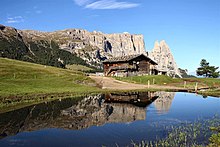Saint Cassian Formation
The St. Cassian Formation ( Italian formazione di San Cassiano ) is a lithostratigraphic formation of the Middle and Upper Triassic in the Southern Alps.
history
Count Georg zu Münster described St. Cassian's marl camp in 1834 . The term layers of St. Cassian was introduced in 1841 by HL Wissmann. Franz von Hauer used the term Cassian layers in 1858 . FT Fürsich and J. Wendt used the modern term Cassian formation for the first time in 1977 .

Definition and distribution area
The formation is the Beck equivalent of the carbonate platforms of Cassian dolomite . It formed in the upper Ladinium and lower Carnium . At the base, the Cassian Formation emerges from the terrigen-volcanoclastic Wengen Formation . The border is blurred, or the formations are interlocked. The reason for this interlocking is, for example, in the Schlern area, repeated pouring of volcanoclastic material from a volcanic island during the period of sedimentation of the St. Cassian Formation, which is formed from marls , limestone marls , limestone and reef breccias. The formation is laterally interlocked with, among other things, the horse-tooth formation . The formation of or with Cassian dolomite, whose carbonate platforms increasingly expanded into the basin, is superimposed and laterally interlocked. Furthermore, the Sankt Cassian Formation is overlaid by the Heiligkreuz Formation and the Dürrenstein Formation . The St. Cassian Formation is a maximum of 400 to 500 meters thick. The formation is named after the town of Sankt Kassian in Val Badia . The type locality is at the Stuores meadows near Badia .
The distribution area of the formation extends from the western Dolomites to the Carnic Alps and in the south to the Valsugana .
description
The formation consists of an alternation of marls, limestone marls and limestone banks as well as arenitic limestone and breccia . The color of the rocks ranges from gray to ocher to brown. In the vicinity of the carbonate platforms there are cipit blocks , which are blocks that have slid from the platforms into the basin.
Fossil guide
A pelagic fauna with sea urchin spines and crinoid stalks can be found in the rocks of the formation . The ammonite and conodont fauna of this formation are known. The ammonites belong to the genera Frankites , Trachyceras , Clionitites , Lobites and Daxatina .
literature
- Autonomous Province of Bolzano-South Tyrol, Office for Geology & Building Materials Testing: Geological map of the Western Dolomites . Scale 1: 25,000, taken from 1992–2007.
Individual evidence
- ↑ Georg zu Münster: About the marl camp of St. Cassian in Tyrol and the ceratites that occur in it. New Yearbook for Mineralogy, Geology and Paleontology, Vienna 1834, pages 1–15. ( limited preview in Google Book search)
- ^ HL Wissmann and Georg zu Münster: Contributions to the geognosy and petrefactology of the South Tyrolean Tyrol, especially the layers of St. Cassian. In: Contributions to Petrefactenkunde , 4: 1-152, Vienna 1841.
- ↑ FT Fürsich, J. Wendt: Biostratinomy and palaeoecology of the cassian formation (Triassic) of the Southern Alps. In: Palaeogeography, Palaeoclimatology, Palaeoecology. 22, 1977, p. 257, doi : 10.1016 / 0031-0182 (77) 90005-0 .
- ↑ Lorenz Keim and a .: Facies interlocking in the basin sediments of the Dolomites (Ladin-Karn): from the outcrop to the geological map 1: 25,000 PDF file ( memento of the original from November 26, 2015 in the Internet Archive ) Info: The archive link was automatically inserted and not yet checked. Please check the original and archive link according to the instructions and then remove this notice.
